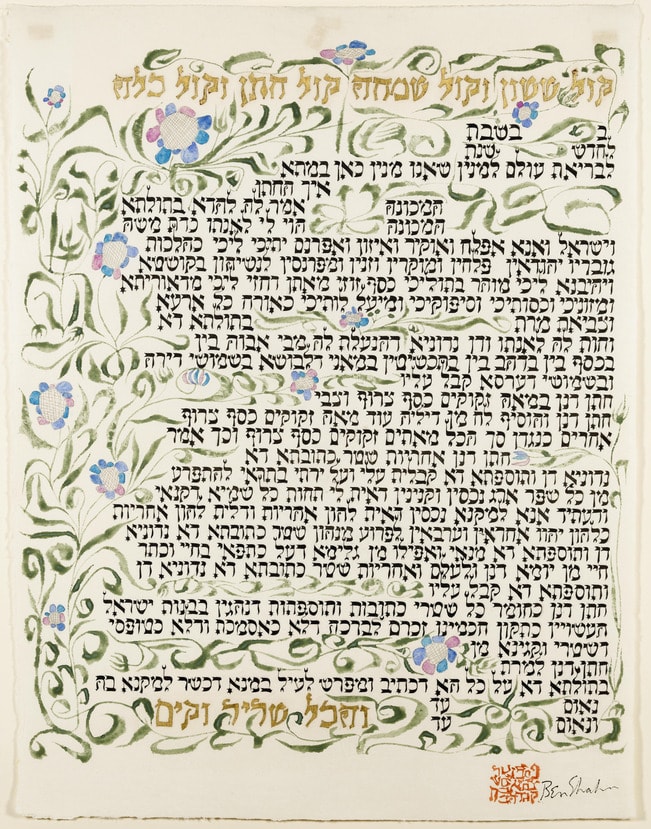
- Object Name:
- Marriage Contract
- Artist/Maker:
- Ben Shahn
- Bio:
- American, b. Lithuania, 1898-1969
- Place Made:
- Roosevelt, New Jersey, United States
- Date:
- 1961
- Medium:
- Ink, watercolor, paint, and graphite on paper
- Dimensions:
- 26 1/2 × 20 1/2 in. (67.3 × 52.1 cm)
- Credit Line:
- Gift of the Albert A. List Family
- Accession Number:
- JM 99-72
- Copyright:
- Art © Estate of Ben Shahn/Licensed by _VAGA_, New York, NY
Not On View
Most decorated Jewish marriage contracts use ornamental motifs as framing devices for their written Aramaic text. Ben Shahn's Ketubbah is a marked departure from this model. In the superb execution of this document, the artist has integrated floral and foliate decorations within his lyrical Hebrew calligraphy, the predominant design element.
While Shahn's artistic personality emerged through the religious themes in his illustrations for the 1931 Haggadah for Passover, he would not return to such subjects for many years. The artist spent most of the 1930s and 1940s as a social realist painter. Along with so many other painters and sculptors during those difficult years, Shahn felt that art could help right the inequities of society. His terse visual commentaries on such topical subjects as the Sacco and Vanzetti case, Nazism, poverty, and labor problems brought him great recognition as both a humanitarian and an artist. It was after World War II that he turned inward through what has been called his transition from social to personal realism. During this period he incorporated allegory and religious and philosophical symbolism in his work, often based on his own cultural heritage.
Shahn's updating of the traditional ketubbah results from his changing stylistic and subjective concerns. He became fascinated with letters, both Hebrew and English, which became essential elements in his work. This calligraphic preoccupation led to his 1954 illustrations for The Alphabet of Creation, a book which related a parable of the origin of the Hebrew alphabet. His own combination of these twenty-two letters become a personal stamp and appears on most of his prints and drawings after 1960, including this Ketubbah. Like the butterfly stamp of James Whistler and the Japonist monogram of Toulouse-Lautrec, this symbol shows Shahn's stylistic inspiration as coming from outside mainstream Western culture.
The expressive style of Shahn's Hebrew characters changes with the meaning of each theme he depicts. For this Ketubbah, which is presented at the joyous celebration of marriage, he develops a commanding but elegant Hebrew appropriate to the legal nature of the document and the solemnity of the moment-a calligraphy markedly different from the flame-like evanescences in his tribute to the Feast of Lights, Hanukkah. As had been the custom of Hebrew scribes throughout the ages, Shahn adds eccentric elements to certain letters. Most notable here is the oft-repeated, stylized Star of David.
Shahn's meandering floral and foliate forms refer to Psalm 128:3, a common visual allusion in Jewish marriage contracts: "Thy wife is a fruitful vine in the midst of thy house, thy children are as young olive trees set around thy table."
While Shahn's artistic personality emerged through the religious themes in his illustrations for the 1931 Haggadah for Passover, he would not return to such subjects for many years. The artist spent most of the 1930s and 1940s as a social realist painter. Along with so many other painters and sculptors during those difficult years, Shahn felt that art could help right the inequities of society. His terse visual commentaries on such topical subjects as the Sacco and Vanzetti case, Nazism, poverty, and labor problems brought him great recognition as both a humanitarian and an artist. It was after World War II that he turned inward through what has been called his transition from social to personal realism. During this period he incorporated allegory and religious and philosophical symbolism in his work, often based on his own cultural heritage.
Shahn's updating of the traditional ketubbah results from his changing stylistic and subjective concerns. He became fascinated with letters, both Hebrew and English, which became essential elements in his work. This calligraphic preoccupation led to his 1954 illustrations for The Alphabet of Creation, a book which related a parable of the origin of the Hebrew alphabet. His own combination of these twenty-two letters become a personal stamp and appears on most of his prints and drawings after 1960, including this Ketubbah. Like the butterfly stamp of James Whistler and the Japonist monogram of Toulouse-Lautrec, this symbol shows Shahn's stylistic inspiration as coming from outside mainstream Western culture.
The expressive style of Shahn's Hebrew characters changes with the meaning of each theme he depicts. For this Ketubbah, which is presented at the joyous celebration of marriage, he develops a commanding but elegant Hebrew appropriate to the legal nature of the document and the solemnity of the moment-a calligraphy markedly different from the flame-like evanescences in his tribute to the Feast of Lights, Hanukkah. As had been the custom of Hebrew scribes throughout the ages, Shahn adds eccentric elements to certain letters. Most notable here is the oft-repeated, stylized Star of David.
Shahn's meandering floral and foliate forms refer to Psalm 128:3, a common visual allusion in Jewish marriage contracts: "Thy wife is a fruitful vine in the midst of thy house, thy children are as young olive trees set around thy table."
Information may change as a result of ongoing research.